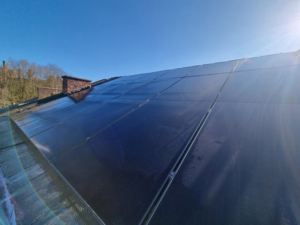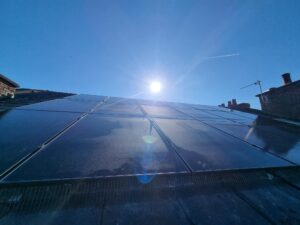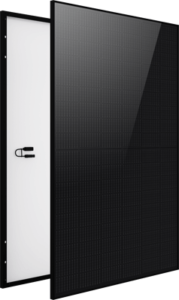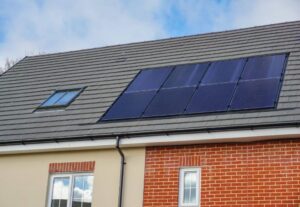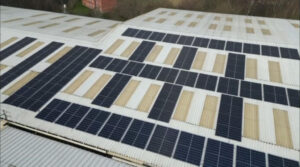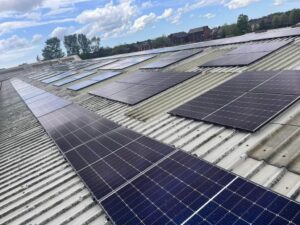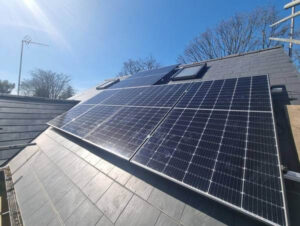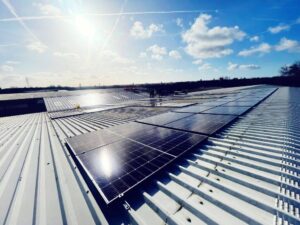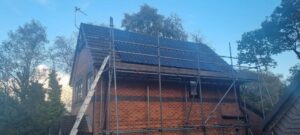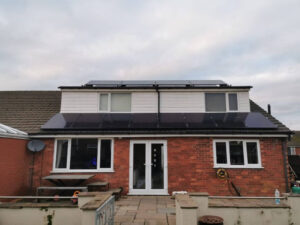The interest in solar panels is predicted to surge even more than it did in 2023, as individuals and businesses alike continue to prioritise sustainable energy sources, whilst making significant savings. The advantages of solar panels extend beyond environmental impact, offering potential financial savings and energy independence. However, it’s crucial to select the right panels for your specific needs. The robustness of the product, its warranty period, cost-effectiveness, and aesthetics are all vital factors to consider when choosing a solar panel. More robust panels offer longevity, while a solid warranty provides peace of mind. Balancing value with aesthetics ensures that your solar panels not only function optimally but also blend seamlessly with your property’s visual appeal.

Let’s delve into the topic of solar panels so that we can gain a deeper understanding before embarking on the journey of finding the perfect one’s for you.
Solar panels, specifically photovoltaic or “PV” panels, are technological marvels that help us harness the boundless energy of the sun and convert it into usable electricity. Each solar PV panel is composed of multiple cells, which are crafted from layers of semiconducting material, usually silicon. When these cells are exposed to light, they generate an electric current. Interestingly, these cells do not require direct sunlight to function effectively and can still produce electricity on overcast days. However, it is important to note that the stronger the sunshine, the more electricity will be generated.
Each individual panel has the ability to generate energy when exposed to sunlight, and a typical domestic solar PV system consists of around 10 such panels, but this can extend to 100’s for a commercial project. The electricity produced by these panels is in direct current (DC) form. Given that UK appliances use alternating current (AC), an inverter is installed alongside the solar PV system to convert the generated DC electricity into AC. This converted electricity can then be used to power your home, or it can be exported back to the grid. Thus, solar panels allow you to take a giant leap toward energy independence while contributing to the sustainability of our planet.

Before deciding to install solar panels, it’s essential to consider the available space. The average system size is around 4kWp, typically occupying about 20 square meters of roof space. Orientation is also vital – an unshaded, South-facing roof is ideal for maximum electrical output. East or West-facing roofs are also feasible options, although they may yield around 15-20% less energy than a South-facing one. North-facing roofs are not recommended due to their limited exposure to sunlight.
Another crucial factor to consider is potential shading. Nearby buildings, trees, or chimneys could cast shadows on your solar panels, negatively impacting their performance. It’s best to find an unshaded spot for your solar system. However, if shading is unavoidable, some solar PV systems can minimise its impact using ‘optimisers’. These devices are not necessary if your installation area is unshaded, and they won’t generate more energy, but instead provide optimised power on individual panels.

To further enhance our understanding of how solar panels function, particularly in conjunction with optimisers, it is important to grasp some additional terminologies, namely `arrays` and `strings`. An `array` refers to the entire group of solar panels. Think of it as the collective body, a complete system comprised of multiple individual components. On the other hand, a `string` is a subset within this array. It is a chain of solar panels connected in series, much like links in a necklace, before they are hooked up to the inverter.
For instance, if you have a solar array of 20 panels, you might have 2 strings of 10 panels each. These strings are then connected to the inverter. The way these strings are set up can play a critical role in the overall performance of your solar panel system, and hence, it’s essential to plan this aspect meticulously.
The role of optimisers comes into play especially when a string within the array is shaded. An optimiser essentially allows each panel within a string to operate independently. This means, if a single panel is shaded, the performance of the other panels within that string won’t be impacted, thereby optimising the power production of each individual panel. Remember, optimisers don’t increase the overall energy generated, they simply ensure that each panel performs at its best, even when others may face issues such as shading.
The role of inverters in a solar panel system is absolutely pivotal. As previously mentioned, inverters convert the DC electricity produced by the solar panels into AC, which is required to power UK household appliances. There are three types of inverters – string inverters, microinverters, and hybrid inverters. String inverters are typically used in larger systems where all panels are subjected to similar lighting conditions. Microinverters are installed on each panel, allowing them to operate independently. Hybrid inverters are indeed akin to string inverters, but with an added feature that transforms them into a versatile choice – the ability to charge and discharge a battery.

The addition of a solar battery storage system can further enhance your solar panel setup. Solar batteries store excess electricity generated by your solar panels during the day, which can be used during the night or when the sun isn’t shining. This can significantly increase your self-consumption of solar power, reduce your reliance on the grid, and provide a backup in case of power outages. Lithium-ion batteries are the most common type used for solar energy storage due to their high efficiency and longevity. When choosing a solar battery, capacity, power rating, depth of discharge (DoD), round-trip efficiency, warranty, and manufacturer reputation should all be considered. Solar batteries can be added to your system at the time of installation or retrofitted later, offering flexibility based on your immediate needs and budget.

The real question we all want to know the answer to: how much can you save with solar panels? Well, the savings from solar panels can be quite substantial, depending on the size of the solar PV system, its location, orientation, and the energy consumption habits of the household. A typical 4kWp solar PV system in the UK can generate around 3,800 kWh of electricity a year. That’s enough to run a typical household’s electricity for about a year. You can expect to save between £600-£1000 in a year. Plus, if you have a solar battery storage system to store excess electricity, you can further reduce your reliance on the grid, leading to savings at the higher end of the scale. Therefore, despite the initial outlay, solar panels can indeed provide substantial savings in the long run, whilst also contributing to a greener future. Not many other home improvements will pay you back, whilst saving you money for decades once you have your return on investment.
If you’re contemplating the feasibility of solar energy for your property, we encourage you to reach out to our team today. We stand ready and eager to offer friendly consultations tailored to your needs. Our experts will provide a comprehensive solar proposal, outlining accurate yield results and potential financial savings. By partnering with us, you can make an informed decision about transitioning to solar power, with clear insights into how it will benefit you economically and environmentally. Get in touch with us today and take the first step towards a greener future.




